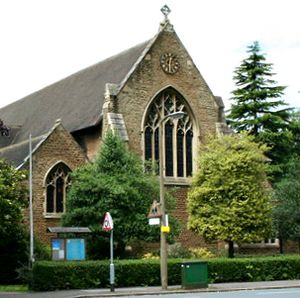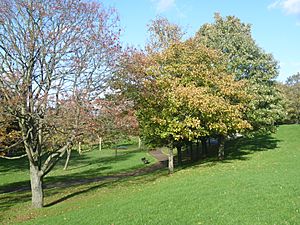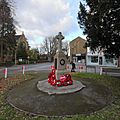Belmont, Sutton facts for kids
Quick facts for kids Belmont |
|
|---|---|
 St. John's Church (C of E), Queens Road, Belmont, Sutton |
|
| Population | 10,048 (2011 Census. Ward) |
| OS grid reference | TQ253620 |
| London borough | |
| Ceremonial county | Greater London |
| Region | |
| Country | England |
| Sovereign state | United Kingdom |
| Post town | SUTTON |
| Postcode district | SM2 |
| Dialling code | 020 |
| Police | Metropolitan |
| Fire | London |
| Ambulance | London |
| EU Parliament | London |
| UK Parliament |
|
| London Assembly |
|
Belmont is a village in South London, England. It is part of the London Borough of Sutton. You can find it near the A217 road and close to Banstead Downs in Surrey. Belmont is a suburban area. It is about 10.8 miles (17.4 km) southwest of Charing Cross, a famous spot in central London.
Contents
History of Belmont
Belmont is a fairly new place. It didn't exist until the late 1800s. The Belmont train station opened in May 1865. It was first called 'California Station'. This name came from a pub nearby called the California Arms. The pub was built around 1858.
The station's name changed to 'Belmont' in 1875. After that, the village that grew around it also took the name Belmont. The original California Arms pub was badly damaged during the Second World War. A new building was put up in 1955. It was first called "The California," then 'The Belmont'. In 2014, it went back to its original name, 'The California'. St. John's Church (C of E) is on Queens Road. It is near the small main street, which is called "Station Road."
How Belmont Grew: Banstead Hospital
Belmont's growth was strongly linked to a large hospital nearby. This hospital was called Banstead Asylum. Even though it was in the area of Banstead, it was much closer to Belmont village and its train station. Today, this hospital site is used by HM Prison High Down.
Belmont Hospital and Old Schools
Belmont also had another hospital called Belmont Hospital. This hospital closed down and was taken apart in the 1980s. Now, a housing area called 'Belmont Heights' stands there. This area is west of Brighton Road.
Before it was Belmont Hospital, the buildings had many different uses. During World War II, it was an emergency hospital. It helped soldiers and civilians who were hurt. The oldest buildings on the site were built in the early 1850s. They were originally a large school for children from poorer families. This school helped children from several areas in south-east London. This school closed in 1902. Some of the buildings from a nearby part of the school, built in 1884, are still standing today.
Important Places
Belmont is home to some important public places.
- The Royal Marsden Hospital is a special hospital. It focuses on treating cancer. It has two locations, and one of them is in Belmont, Sutton. The buildings here were once part of the South Metropolitan District School. This was a school for children whose parents were in workhouses. In the 1890s, girls stayed at the Banstead Road site. Boys stayed at a site on Brighton Road. The Brighton Road site later became Belmont workhouse and then Belmont Psychiatric hospital. It was taken down in the 1980s. The Banstead Road site later became a place for sick people to recover. In 1962, the Royal Marsden Hospital took over the southern part of this site.
- The Institute of Cancer Research is a public research institute and university. It is in London and specializes in studying cancer. It started in 1909 as a research part of the Royal Marsden Hospital. Its Belmont, Sutton campus opened in 1956. It joined the University of London in 2003.
- Sutton Hospital is also in the area.
Green Spaces
Belmont has nice green areas. Besides Belmont Park, there are two Local Nature Reserves. These are special places for nature.
- Cuddington Meadows is a very important nature site. On old maps, it was shown as two open areas on Banstead Downs. Later, it was part of a farm. This farm became Cuddington Hospital in 1897. The hospital closed in 1984. In the late 1990s, the land was given to Sutton Council. They manage it to protect nature. It has mostly chalk grassland and some bushes. Many unusual flowering plants grow here. These include greater knapweed, lady's bedstraw, and field scabious.
- Belmont Pastures is another important nature site. It is a long, narrow triangle of land north of Belmont train station. This is an old meadow. It used to belong to Belmont Hospital.
Just south of the village is Banstead Downs. This large natural area covers about 430 acres (170 ha). It stretches for about a mile towards Banstead, Surrey. Banstead Golf Course is on its northern slopes.
Local Shops and Services
Station Road is the main shopping street in Belmont Village. It has many shops and restaurants. Most of them are independent, meaning they are not big chain stores. This street runs for about a quarter of a mile. It goes from Belmont Station in the east to St John's Church in the west. About a mile north of Belmont is Sutton, which is a larger town with more shops and services.
Nearby Places
- Sutton (to the north)
- Cheam (to the west)
- Banstead, Surrey (to the south)
- Carshalton (to the east)
Transport
Belmont train station is on a branch line. This line goes from Sutton to Epsom Downs. It is also on the line from London Victoria to Epsom Downs. The train services are run by Southern rail. Belmont is in London Travelcard Zone 5. TfL buses also run in this area.
Famous People Who Lived Here
- David Bellamy (1933–2019), a well-known botanist and author.
- Robin Hull (1905-1960), a music critic.
- James Hunt (1947–1993), a World Formula One motor-racing champion in 1976.
- Lord Judd (1935-2021), who used to be the director of Oxfam. He was also a Member of Parliament.
- Don Lusher (1923–2006), a famous trombonist and jazz band leader.
- Lord Ritchie-Calder (1906–1982), a journalist and expert on the environment.
- Lionel Tertis (1876–1975), a famous viola player.
- Barry Wordsworth (born in Cheam 1948), an orchestral conductor.
Images for kids
-
The Chilterns art deco apartments on Brighton Road.





